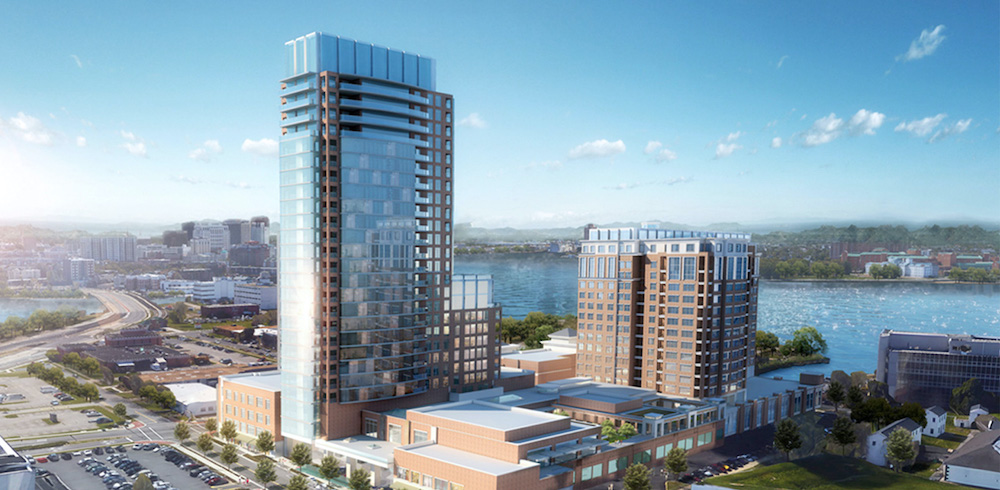While highrise senior living projects are grabbing headlines in major metropolitan areas such as New York City and Washington, D.C., the trend is also playing out in smaller cities around the country. One case in point is a 24-story continuing care retirement community (CCRC) expansion that recently topped out in Norfolk, becoming the tallest residential building in the Virginia city.
But while this project is part of a current surge in urban senior living development, its genesis dates back two decades. That’s when Neil Volder, the developer and CEO of the community, acquired a prime piece of real estate right on the harbor, about two miles from downtown and next to the regional health center.
“This was back in 2000, people weren’t talking about highrises — The Clare wasn’t there, Mirabella wasn’t there,” Volder told Senior Housing News. “I was just lucky enough to find a great piece of property that had all the ingredients of what people want today: urban living, two miles from all the cultural events.”
Even in 2000, Volder was confident in his vision for a CCRC that felt more like an upscale hotel than a retirement community. His confidence proved to be justified. All units in the first phase of the CCRC — dubbed Harbor’s Edge — sold out in nine weeks, and the first residents moved into the Harbor Tower building in 2006.
Volder’s intention was always to build a second tower, and planning began in earnest for that about six years ago. Now, that project is moving toward completion, with plans to open next summer. Dallas-based three is the architect and StudioSIX5 is doing the interior design.
The project is about 80% pre-sold, which Volder believes shows the enduring appeal of the urban CCRC model even in the face of consumers’ Covid-19 concerns. In this regard, he echoes Mather CEO Mary Leary, who recently shared successful sales figures for that organization’s forthcoming highrise near Washington, D.C.
The new Harbor’s Edge highrise has been dubbed the River Tower, and will bring 147 new residences to the Norfolk market, featuring open floor plans and floor-to-ceiling windows. The project also is adding more than 90,000 square feet of common space. While the construction was too far advanced to make any substantial design changes in light of Covid-19, expansive common areas and large residential units are conducive to activities with social distancing and comfortable living if in quarantine.
In terms of how that common space is being used, amenities include a 44-seat theater, a library, a fitness center that will be utilized by both towers, a 65,000-foot grand hall, a media room that can be reserved for up to 18 people, and a $100,000 golf simulator room — a particularly popular feature.
“I’ve had so many people talk about that, we’ve got $100,000 worth of publicity,” Volder said.
Dining is a key component of the Harbor’s Edge lifestyle, and the new tower will bring multiple new dining venues. These include a lobby bar; a restaurant serving small-plate appetizers and entrees featuring fusions of different regional cuisines; and a venue with a pizza oven that will also serve burgers, sandwiches, salads and the like.
The dining concepts are developed by Executive Chef Beat Meier, who trained in Europe and spent 12 years as the executive chef of Richmond’s exclusive Country Club of Virginia before joining Harbor’s Edge last year.
“I’d never been inside a retirement community, but when I came here, it really does have a feeling of an upscale hotel [or] country club,” he told SHN. “That’s the feeling I want, to go forward.”
The new dining venues will be supported by a state-of-the-art kitchen, which was designed in consultation with Meier. The kitchen will feature combi ovens, cryovac equipment and sous vide cooking.
In addition to the newly constructed dining venues, the existing steakhouse-style venue in the Harbor Tower is being renovated — part of a comprehensive upgrade to that building that is being done along with the new construction. Among other planned changes to the Harbor Tower is the creation of an expansive palm court lobby.
“I was told so many times, when you build a new expansion, people want the new and they don’t want the old,” Volder said. “It’s one community, two towers.”
In fact, the two towers will be literally unified, connected at the third floor.
The renovations to the Harbor Tower will total about $9 million, Volder said. Between $2 million and $3 million came out of normal capital expenditures and the balance is being funded through the $200 million package that is also financing construction of the River Tower. HJ Sims handled the financing, which is split between 50% long-term bonds and 50% bank financing through SunTrust and TD Bank, which brought costs down, Volder noted.
In terms of rates, Harbor’s Edge offers different entrance fees with variable levels of refundability, ranging from about $300,000 to more than $2 million. Harbor’s Edge is self-managed with Volder at the helm, but Greystone has advised in the past. And Volder is mulling retirement in the not-too-distant future, at which point bringing in a management company might again be under consideration.
But even if he is no longer Harbor’s Edge CEO, Volder will not be far away. He has reserved one of the penthouses for himself.
“I’ve sold so many units over the last 15, 16 years that I’ve sold myself,” he said.
Companies featured in this article:
Harbor's Edge, HJ Sims, Mather, studioSIX5, three: Living Architecture




